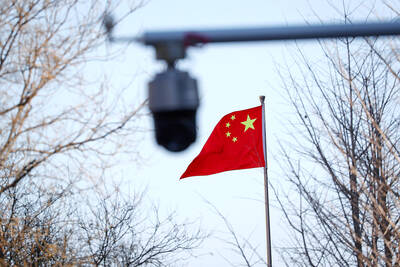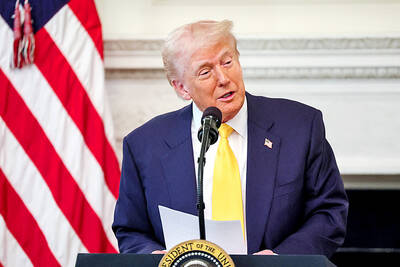Japan’s central bank yesterday unveiled details of a new US$33 billion low-interest lending scheme intended to fuel economic growth and fight deflation.
The plan accompanied a decision by the Bank of Japan (BOJ) to keep its key interest rate near zero.
As widely expected, the eight-member policy board voted unanimously to leave the overnight call rate target at 0.1 percent.
The BOJ has not touched the rate since December 2008.
The bank cited robust overseas demand for helping the world’s second-biggest economy continue a moderate recovery. Exports and output are up, and corporate capital investment is climbing. Government stimulus measures are also driving domestic demand.
The jobs and wages situation “remained severe, but the degree of severity has ease somewhat,” the BOJ said. It pledged to keep monetary policy “extremely accommodative” to fight deflation and foster sustainable growth.
Still, the bank faced persistent political pressure to do more as prices in the country continued to fall. Deflation plagued Japan during its “Lost Decade” in the 1990s, hampering growth by depressing company profits, sparking wage cuts and causing consumers to postpone purchases.
The new credit program, first announced last month, is designed to encourage private banks to lend money to businesses in growth sectors such as environment, energy, elderly care and tourism.
“The most critical challenge the Japanese economy is currently facing is to raise the potential economic growth rate and productivity,” the BOJ said in its statement.
“The fund-provisioning measure aims to act as a catalyst for financial institutions in making efforts toward strengthening the foundations for economic growth” and to broadly support financial institutions’ own initiatives, it said.
Through the lending facility, commercial banks will have access to a total ¥3 trillion (US$32.8 billion). Approved banks will be able to borrow up to ¥150 billion each for up to four years at an annual interest rate of 0.1 percent.The BOJ aims to start the program by the end of August.
The bank’s latest move met with skepticism among economists, who question whether companies need more loans.
“We reiterate that we see little impact at this stage due to a lack of demand for funds and rising corporate fund surpluses,” Goldman Sachs economist Chiwoong Lee said.

AT RISK: The council reiterated that people should seriously consider the necessity of visiting China, after Beijing passed 22 guidelines to punish ‘die-hard’ separatists The Mainland Affairs Council (MAC) has since Jan. 1 last year received 65 petitions regarding Taiwanese who were interrogated or detained in China, MAC Minister Chiu Chui-cheng (邱垂正) said yesterday. Fifty-two either went missing or had their personal freedoms restricted, with some put in criminal detention, while 13 were interrogated and temporarily detained, he said in a radio interview. On June 21 last year, China announced 22 guidelines to punish “die-hard Taiwanese independence separatists,” allowing Chinese courts to try people in absentia. The guidelines are uncivilized and inhumane, allowing Beijing to seize assets and issue the death penalty, with no regard for potential

STILL COMMITTED: The US opposes any forced change to the ‘status quo’ in the Strait, but also does not seek conflict, US Secretary of State Marco Rubio said US President Donald Trump’s administration released US$5.3 billion in previously frozen foreign aid, including US$870 million in security exemptions for programs in Taiwan, a list of exemptions reviewed by Reuters showed. Trump ordered a 90-day pause on foreign aid shortly after taking office on Jan. 20, halting funding for everything from programs that fight starvation and deadly diseases to providing shelters for millions of displaced people across the globe. US Secretary of State Marco Rubio, who has said that all foreign assistance must align with Trump’s “America First” priorities, issued waivers late last month on military aid to Israel and Egypt, the

‘UNITED FRONT’ FRONTS: Barring contact with Huaqiao and Jinan universities is needed to stop China targeting Taiwanese students, the education minister said Taiwan has blacklisted two Chinese universities from conducting academic exchange programs in the nation after reports that the institutes are arms of Beijing’s United Front Work Department, Minister of Education Cheng Ying-yao (鄭英耀) said in an exclusive interview with the Chinese-language Liberty Times (the Taipei Times’ sister paper) published yesterday. China’s Huaqiao University in Xiamen and Quanzhou, as well as Jinan University in Guangzhou, which have 600 and 1,500 Taiwanese on their rolls respectively, are under direct control of the Chinese government’s political warfare branch, Cheng said, citing reports by national security officials. A comprehensive ban on Taiwanese institutions collaborating or

France’s nuclear-powered aircraft carrier and accompanying warships were in the Philippines yesterday after holding combat drills with Philippine forces in the disputed South China Sea in a show of firepower that would likely antagonize China. The Charles de Gaulle on Friday docked at Subic Bay, a former US naval base northwest of Manila, for a break after more than two months of deployment in the Indo-Pacific region. The French carrier engaged with security allies for contingency readiness and to promote regional security, including with Philippine forces, navy ships and fighter jets. They held anti-submarine warfare drills and aerial combat training on Friday in